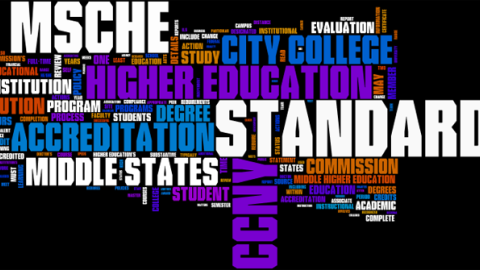MSCHE Standards
*Four principles guided the development of the MSCHE standards:
- The mission-centric standards acknowledge the diversity of institutions;
- The focus of the standards is on the student learning experience;
- The standards emphasize institutional assessment and assessment of student learning;
- The standards support innovation as an essential part of continuous institutional improvement.
These standards affirm that the individual mission and goals of each institution remain the context within which these accreditation standards are applied. They emphasize functions rather than specific structures, recognizing that there are many different models for educational and operational excellence. Each standard is expressed in one or two sentences and is then followed by criteria. The criteria specify characteristics or qualities that encompass the standard. Institutions and evaluators will use these criteria together with the standards, within the context of institutional mission, to demonstrate or determine compliance. Institutions and evaluators should not use the criteria as a checklist.
Standard I: Mission and Goals
The institution’s mission defines its purpose within the context of higher education, the students it serves, and what it intends to accomplish. The institution’s stated goals are clearly linked to its mission and specify how the institution fulfills its mission.
Standard II: Ethics and Integrity
Ethics and integrity are central, indispensable, and defining hallmarks of effective higher education institutions. in all activities, whether internal or external, an institution must be faithful to its mission, honor its contracts and commitments, adhere to its policies, and represent itself truthfully
Standard III: Design and Delivery of the Student Learning Experience
An institution provides students with learning experiences that are characterized by rigor and coherence at all program, certificate, and degree levels, regardless of instructional modality. all learning experiences, regardless of modality, program pace/schedule, level, and setting are consistent with higher education expectations.
Standard IV: Support of the Student Experience
Across all educational experiences, settings, levels, and instructional modalities, the institution recruits and admits students whose interests, abilities, experiences, and goals are congruent with its mission and educational offerings. The institution commits to student retention, persistence, completion, and success through a coherent and effective support system sustained by qualified professionals, which enhances the quality of the learning environment, contributes to the educational experience, and fosters student success.
Standard V: Educational Effectiveness Assessment
Assessment of student learning and achievement demonstrates that the institution's students have accomplished educational goals consistent with their program of study, degree level, the institution's mission, and appropriate expectations for institutions of higher education.
Standard VI: Planning, Resources, and Institutional Improvement
The institution’s planning processes, resources, and structures are aligned with each other and are sufficient to fulfill its mission and goals, to continuously assess and improve its programs and services, and to respond effectively to opportunities and challenges.
Standard VII: Governance, Leadership, and Administration
The institution is governed and administered in a manner that allows it to realize its stated mission and goals in a way that effectively benefits the institution, its students, and the other constituencies it serves. even when supported by or affiliated with governmental, corporate, religious, educational system, or other unaccredited organizations, the institution has education as its primary purpose, and it operates as an academic institution with appropriate autonomy.
*Excerpted from MSCHE Standards for Accreditation and Requirements of Affiliation
Verification of Compliance
*The Middle States Commission on Higher Education, as a federally recognized accreditor, is obligated to ensure that its candidate and member institutions comply with the accreditation-relevant federal regulations developed by the U.S. Department of Education in the Higher Education Opportunity Act of 2008. Further, the Commission is required to review candidate and member institutions’ continued compliance with Title IV program responsibilities. Commission policy regarding federal compliance requirements for institutions was revised and enacted in January 2013, indicating that institutions must
meet these federal regulations to be accredited by the Commission. In response to this, it is assumed that the institution will provide documentation of policies and procedures that are (1) in writing, (2) approved and administered through applicable institutional processes, and (3) published and accessible to those affected. This document is focused on the Commission’s verification of institutional compliance in several areas:
Student identity verification in distance and correspondence education
Transfer of credit policies and articulation agreements
Title IV program responsibilities
Institutional records of student complaints
Required information for students and the public
Standing with state and other accrediting agencies
Contractual relationships
Assignment of credit hours
*Excerpted from MSCHE Verification of Compliance with Accreditation-Relevant Federal Regulations
Last Updated: 03/06/2017 15:16
